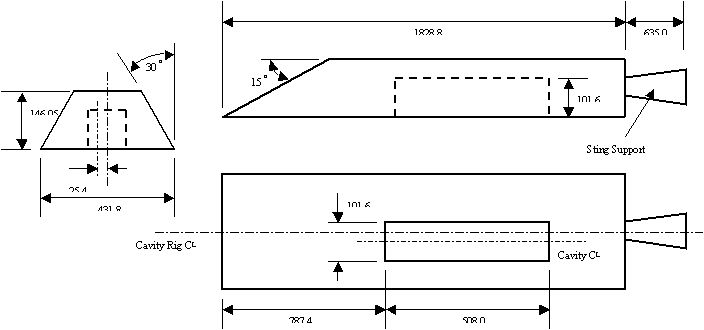Description AC1-01
Aero-acoustic cavity
Application Challenge 1-01 © copyright ERCOFTAC 2004
Introduction
This application challenge is proposed by Computational Dynamics, Partner 34 of the QNET-CFD Thematic network.
The test case is derived from testing of the M219 cavity model and formed part of a joint BAe/DERA (now BAE SYSTEMS and QuinetiQ, respectively) programme at the ARA transonic wind tunnel at Bedford. The wind tunnel model configuration is shown in Figure 1 (section 1.4) and consists of an empty, rectangular cavity, with an L/D ratio of 5, set into the flat surface of the rig.
Cavity flows are of general interest in both low and high-speed environments, for from the point of view of comfort (passengers experiencing acoustic buffeting in automotive cabins) and component reliability (equipment in aircraft cavities). This poses a significant challenge to the modellers insofar as it is a multi-physics problem; fluid flow modelling needing to be carefully specified to fulfil the requirements for dipole and quadrupole acoustic source prediction. The modeller’s challenges are towards building and understanding of the effects of, and minimum requirements related to;
- Space and time discretisation (and associate CFD solver methodologies).
- Using appropriate turbulence modelling (suitability of RANS, LES and combinations thereof).
- Achieving reasonable run times for three-dimensional geometries of industrial interest.
Relevance to Industrial Sector
This test case from the M219 study, although simple in geometry, contains all the factors relevant to the modelling of aeroacoustic dipole and quadrupole sources. Prediction of the tonal, high-energy narrow-band modes are of particular interest in structural design (fatigue), and at high flow speeds the mechanisms that generate broad-band modes need to be understood from the viewpoint of noise attenuation. Also, knowledge of the flow patterns within and around the cavity give an improved indication of the behaviour or acoustic perception by objects in the cavity volume.
This application challenge represents an ideal assessment of the ability of CFD codes to predict the detailed flow physics and acoustic nature of a simple cavity within industrially acceptable run times.
Design or Assessment Parameters
The means by which the CFD is validated against measurements is point-wise pressure histories. These data, processed via Fourier Transforms, allow the analysis of the acoustic tone signatures; in particular the power spectral density, RMS pressure and sound pressure level.
Flow Domain Geometry
Figure 1. Experimental Rig of the M219 Cavity Model.
Flow Physics and Fluid Dynamics Data
The shear layer upstream of the cavity separates at the cavity leading edge producing re-circulating flow inside the cavity. The mechanism by which this re-circulating flow becomes unsteady and periodic (hence producing acoustic tones) is described by researchers to be that pressure waves reflecting off the back face of cavity interact with the separating shear-layer producing instability. This phenomenon is probably irrespective of the flow regime (low or high speed).
The dominant aeroacoustic noise source changes from dipole at low Mach number, to quadrupole at high Mach number.
For this case, the flow is compressible (high subsonic, probably containing pockets of sonic flow), turbulent and has ideal gas properties (air). The test geometry is assumed to be rigid (no acoustic damping).
© copyright ERCOFTAC 2004
Contributors: Fred Mendonca; Richard Allen - Computational Dynamics Ltd
Site Design and Implementation: Atkins and UniS
Top Next
